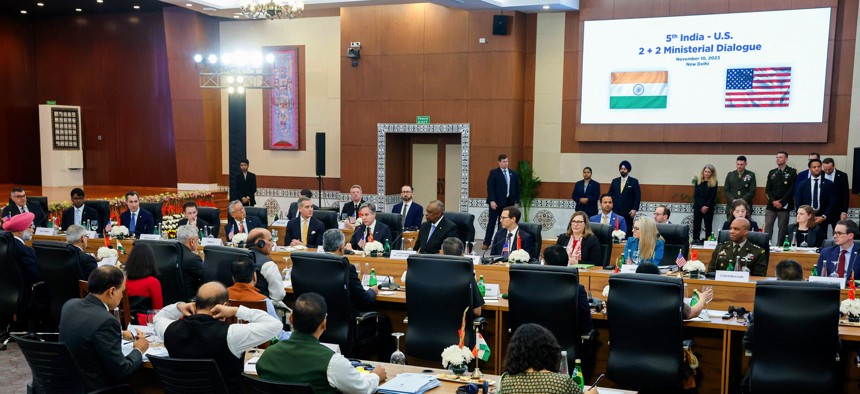
U.S. Secretary of State Antony Blinken, India's External Affairs Minister Subrahmanyam Jaishankar, U.S. Defense Secretary Lloyd Austin and his Indian counterpart Rajnath Singh attend the India-US 2+2 ministerial dialogue in New Delhi on November 10, 2023. JONATHAN ERNST/POOL/AFP via Getty Images
India plans to make armored vehicles with US help, officials say
Defense Secretary Lloyd Austin announced the deal during a bilateral meeting with State Secretary Antony Blinken and Indian ministers of defense and external affairs.
NEW DELHI—The U.S. and India plan to co-produce Stryker armored vehicles in a move designed to boost India’s military capabilities and deter China, defense officials announced Friday.
“Working together to co-produce an armored vehicle…that is extremely important,” Defense Secretary Lloyd Austin told reporters following a bilateral meeting with Indian prime ministers of defense and external affairs.
The deal, once complete, will lead to the first production of Strykers abroad, a senior U.S. defense official told reporters. It could also give India capabilities that would help it deter aggression from neighboring China.
The Biden administration has had several engagements with India this year, including meetings between President Joe Biden and Prime Minister Narendra Modi in New Delhi and Washington. Austin and State Secretary Antony Blinken have also made trips this year.
“This year has been a transformative period in U.S.-India relations. Prime Minister Modi’s visit to the United States this summer and President Biden’s trip to India for the G-20 Summit both demonstrated the strength of our partnership,” Austin said in his opening remarks at the Friday meeting.
“It would be the first time that Strykers have ever been produced in a foreign partner nation. It also has a lot of potential in the future to give India more capability in areas that are particularly relevant along the line of actual control, some of the challenges that it has with the PRC,” the senior defense official said.
As the U.S. provides more weapons to India, Austin said the U.S.-India relations were “stronger than ever” and that it's not just about China.
“We have a common goal, a common view of the Indo Pacific and that is that the Indo Pacific should remain free and open,” Austin told reporters. “But our relationship is not just based on China, on the challenges that China presents. It's based upon…shared values.”
The U.S. and India previously agreed to co-produce F414 fighter jet engines for the Indian Air Force in June. There’s also a push for more unmanned systems and to expand the U.S. Navy shipyard repairs in India.
“This is tremendous, tremendous progress in a very short period of time,” Austin said.
Over the past year, the Navy has signed two agreements and is negotiating more so the U.S. Navy ships can be repaired and refueled in Indian shipyards, a senior defense official said. Moreover, India announced plans to seek full membership of the Combined Maritime Forces in Bahrain, which would give the country the ability to lead task forces.
Earlier this year, the U.S. and India released a strategic roadmap to explore projects around several tech problems, including munitions systems, mobility, air combat support, intelligence and surveillance, and undersea domain awareness. As part of that effort, the countries are holding tech challenges to find the best solutions for oil spill detection and tracking and high-speed undersea communications. Top prize is $150,000 for each competition.
This increased alignment could not only be a boon for India economically but can also allow the country to become a U.S.-allied hub for defense needs in the Indo-Pacific region—and an alternative to Russia and China.
“Having another center and one that is aligned with us on our strategic interests becomes really important,” a senior defense official told reporters.




